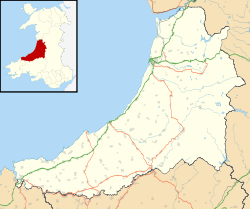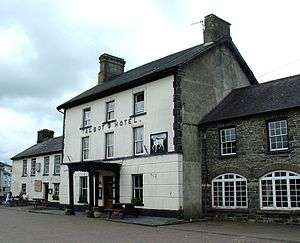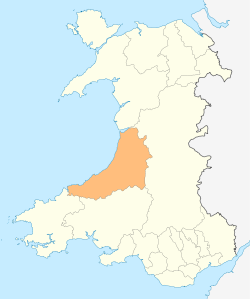Tregaron
| Tregaron | |
 |
|
 Tregaron |
|
| Population | 1,173 (2011)[1] |
|---|---|
| OS grid reference | SN679597 |
| Principal area | Ceredigion |
| Country | Wales |
| Sovereign state | United Kingdom |
| Post town | TREGARON |
| Postcode district | SY25 |
| Dialling code | 01974 |
| Police | Dyfed-Powys |
| Fire | Mid and West Wales |
| Ambulance | Welsh |
| EU Parliament | Wales |
|
|
Coordinates: 52°13′11″N 3°56′07″W / 52.21962°N 3.93517°W
Tregaron is a market town in the county of Ceredigion, Wales, lying on the River Brenig (also Brennig), a tributary of the River Teifi. The town is twinned with Plouvien, in Finistere, France.[2] According to the 2011 Census, the population of the ward of Tregaron was 1,173 and 67% of the population could speak Welsh.[1]
History
Tregaron received its royal charter as a town in 1292.[3]:p7 It owes its origin and growth to its central location in the upper Teifi Valley. It was the market town for the scattered agricultural communities in the broad, fertile countryside to the south and the rich landowners with extensive holdings in the uplands to the east, the home of many sheep and few people. To the north was Cors Caron which was a fertile land when drained, and to the west a hilly region with self-sufficient farmers on smallholdings of a few acres. These people all converged on Tregaron for the weekly market and the annual fair, Ffair Garon, where the sale of poultry, pigs, cattle and horses took place. The charter for the yearly fair was granted by Edward I in the 13th century.[4] Sheep fairs were held in May and June and two hiring fairs took place in November. A large number of taverns and inns in the town catered for the influx of country folk to these events.[5]:p30
In the middle of the 18th century, Matthew Evans kept an inn in the town. He had two sons and a daughter who were celebrated robbers and collectively known as Plant Mat ('Matthew's children' in English). They lived for several years in a cave near Devils Bridge which still bears their name. They terrorized the district and would give to their friends a glove to act as a passport and identify them to their brethren. It was difficult to apprehend the trio because of the narrowness of the entrance to the cave which made it impossible to storm. After several years of success, they committed a murder and, eventually being taken, were sentenced to death and executed.[6]:p240
Tregaron was a main gathering place for the drovers who, before the advent of rail transport, herded large numbers of cattle, sheep and even geese hundreds of miles to the markets of south-east England. Many Tregaron men were drovers and accumulated considerable wealth in the process. They acted as news carriers and unofficial postmen and some were adept at avoiding tollgates.[5]:p31
The Tregaron area had a number of water-driven woollen mills and was a centre for the manufacture of hosiery. Woollen socks were knitted at home by men, women and children and sold at the market, often to dealers who resold them in the industrial valleys of South Wales.[5]:p32
Culture and community
The church is dedicated to St Caron. He was a man of lowly origins but "his courage and generous deportment obtained him the sovereignty in Wales: he made war against the Romans, reigned seven years and was buried in Tregarron".[6]:p242 He is almost certainly the same person as Carausius (Roman name)[7] who took power in Britain in 286 and was assassinated in 293 by Allectus (also see Carausian Revolt). According to Geoffrey of Monmouth in the translation from Welsh "there was a young man of the name of Caron, of a British family, but of low degree, who... went to Rome, and solicited the Senate to grant him permission and aid to protect the sea coasts of Britain... [He] proposed to the Britons that they should make him king... Allectus with three legions... overpowered him..."[7] An early Christian stone slab bearing the name Carausius and the Chi Rho symbol is preserved in Penmachno. The church has a tower and stands on a rocky eminence. It consists of a simple nave and chancel.
Other notable buildings in the town include the 13th-century Talbot Hotel, which supposedly has an elephant buried in its grounds.[8][9] The remote chapel Soar y mynydd is close to Tregaron. In March, 1977, a cottage near Tregaron was one target of an Operation Julie police raid in which vast quantities of the drug LSD were seized.[10][11]
Nearby Cors Caron (Tregaron Bog), is known for its adders, buzzards and red kites. The River Brenig is noted for its brown trout and eels. The river has been the subject of dredging and flood-protection works to provide 1-in-100-year flood protection to the town and improve the environment for wildlife along a stretch of river.[12]
During the Second World War, the War Office used a site near Tregaron for training exercises. Continuation of such use after the war was the subject of protest by Plaid Cymru.
Music and the arts
An annual eisteddfod is held in the town each September, drawing performers from all parts of Wales and beyond. Eisteddfodau have been conducted at Tregaron for a century or more. The Caron Male Voice Choir was formed in 1969 and has performed in Europe and America as well as the UK.[13]
Sports
The town holds an annual festival of harness racing in August, which attracts racegoers from across the UK. This was started in 1980 by the Tregaron Trotting Club.[14] A race day is now held early in May each year.[15]
The Tregaron Rugby Football Club plays in Division Two West C of the Welsh Rugby Union, having won promotion from Division 3 in 2015.[16]
An association football team, Tregaron Turfs F.C., plays in the Cambrian Tyres Aberystwyth and District League Division 1[17]
Public transport
In 1860, government subsidisation was approved for the construction of a railway from Manchester to Milford Haven. At the urging of local people led by David Davies and supported by Joseph Jenkins, capital was subscribed for a station at Tregaron.[18]:pp 70–72 The section from Pencader to Lampeter was completed in January 1866 and the grand opening of the entire line was held at Aberystwyth on 12 August 1867.[18]:pp 79 providing a boost to the economy of the town.
Tregaron's train service was withdrawn and the station closed in 1965 after the line was badly damaged by flooding south of Aberystwyth. There is an approximately two-hourly bus service to Aberystwyth and Lampeter and a more sporadic service to other neighbouring small towns and villages but, as with many rural areas, there are no buses after approximately 18.00 in the evening and none at all on Sundays and bank holidays.
Education
The Tregaron district has one secondary school, Tregaron Secondary School, and seven primary schools - Tregaron, Lledrod, Bronnant, Llangeitho, Penwuch, Pontrhydfendigaid and Llanddewi Brefi,[19] which are administered by the Ceredigion County Council.[20]
Notable people
- Joseph Jenkins ("the Welsh Swagman")
- the "Welsh Robin Hood", Twm Siôn Cati
- Henry Richard (1812–1888), known as the "Apostle of Peace", was a Member of Parliament, a minister and secretary of the Peace Society[21]
- Artist Ogwyn Davies (1925–2015)
- Ceramic artist Julie Richards[22]
- Roy Clews, author of To Dream of Freedom: The Story of MAC and the Free Wales Army[23] and other books
- Evan Shelby (1720-1794), American frontiersman
Image gallery
 River Brenig at Tregaron
River Brenig at Tregaron The Talbot Hotel
The Talbot Hotel Talbot Hotel interior
Talbot Hotel interior View of St Caron's church
View of St Caron's church Main street
Main street Memorial Hall
Memorial Hall Commercial/professional centre
Commercial/professional centre
References
- 1 2 "Area: Tregaron (Ward)/ Welsh Language Skills, 2011 (QS206WA)". Office for National Statistics. Retrieved 13 May 2015.
- ↑ Twinning database
- ↑ Tregaron: Images of a country town Tregaron and District Historical Society & Landmark Publishing UK, 2006. ISBN 1-84306-197-X
- ↑ Jones, Emrys Tregaron: The Sociology of a Market Town in Central Cardiganshire in "Welsh Rural Communities", Ed. Davies E., Rees A. D., University of Wales Press, Cardiff 1960, p. 71
- 1 2 3 Jenkins, J. Geraint: Ceredigion: Interpreting an Ancient County. Gwasg Careg Gwalch, 2005
- 1 2 Meyrick, Samuel Rush. The History of Cardiganshire. S. A. Collard (1907]
- 1 2 Geoffrey of Monmouth; Roberts, Peter (1811). The Chronicle of the Kings of Britain. London: E Williams. p. 93.
- ↑ "University archaeologists to dig for Tregaron elephant". BBC News. 10 March 2011. Retrieved 11 March 2011.
- ↑ The Tregaron Elephant Project: Myth, story and legend at School of Archaeology, History and Anthropology, The University of Wales Trinity Saint David, April 2011
- ↑ "On 26 March 1977, in Wales, England and France, Operation Julie officers swooped and arrested some 120 suspects." BBC Wales account Archived November 9, 2007, at the Wayback Machine.
- ↑ Operation Julie: How an LSD raid began the war on drugs BBC Magazine 12 July 2011)
- ↑ Tregaron Flood Alleviation Scheme, Ceredigion. Best Practice Awards 2010 at British Precast website
- ↑ Caron Male Voice Choir at BBC Mid Wales
- ↑ Tregaron Trotting Club article at BBC Mid Wales
- ↑ Tregaron Trotting Club Official site
- ↑ Tregaron claim SSE SWALEC Division 3 West C title at Wales Online
- ↑ Jones R. Fixtures and results at Cynghrair Cambrian Tyres Aberystwyth League, 31 May 2016
- 1 2 Phillips, Bethan Pity the Swagman (Cymdeithas Lifrau Ceredigion Gyf., Aberystwyth 2002)
- ↑ "Ceredigion cabinet supports 'super-school' in Tregaron". BBC News. BBC. 6 July 2010. Retrieved 13 April 2011.
- ↑ "Primary Schools". at Ceredigion County Council. Archived from the original on 4 July 2011. Retrieved 14 April 2011.
- ↑ Henry Richard Manuscripts at National Library of Wales. Accessed 6 January 2016
- ↑ Julie Richards at BBC Mid Wales, 28 August 2006
- ↑ To Dream of Freedom: The Story of MAC and the Free Wales Army at amazon.co.uk. Accessed 7 January 2016
External links
| Wikimedia Commons has media related to Tregaron. |
- Tregaron Portal page at BBC Mid Wales
- Tourist information
- GENUKI page
- Aerial photograph of Tregaron
- History of Tregaron
- Tregaron nature walk
- Tregaron Trails—Selection of local walks
